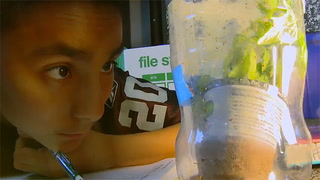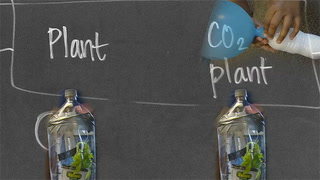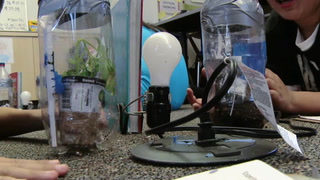Classroom Close Up: Climate Change in a Bottle – Overview
with Suney Park
[01:00:10;22]
Suney: "We're gonna get started with our, um, experiment that we've been preparing for. You guys know..."
Today in class, you were watching my sixth graders take what they've been learning about climate change, specifically the greenhouse effect, and with this experiment, make the greenhouse effect happen right before their eyes.
"Alright. Scientists, scholars, and climate change researchers, are you ready?"
Students: "Yes."
Suney: "When I say 'Go!', you're gonna turn the light on. Do your best. 5..4..3..2..1 Go!"
In our model, the light bulb is the sun. For the earth, a soda bottle. Anything that can be broken down to the basics can be taught.
"Why is the greenhouse effect important? And, what does it have to do with climate change? Roberto?"
Student: "Like, if CO2, well, the main question is will temperature change if carbon dioxide is added to the atmosphere?"
Suney: "Excellent."
I wanted the students to have an experience. So they designed the experiment themselves. All I did was show them a soda bottle and I said "How can we re-create the earth and its atmosphere in this model?"
"I could test it out by look, by doing something to this model."
And then they told me what to add to it.
"So, you guys said, why don't we add some, um, carbon dioxide to one of the bottles. True?"
So they designed each of the four experiments. They were specifically adding different variables to what would be the atmosphere.
"If you are a plant person, you're gonna put one of the thriving plants in, and then you're gonna put whatever else you need too - your thermometer, which are over here."
Before doing the experiment, we had to talk about the setup. And, not just like, let them go right away, but we had to really um, make it so it was broken down into steps. OK, so first, we're gonna take our bottle.
"The caps need to be put on. It's gonna be a closed system."
Second, we're gonna cut off the top.
"Carefully, in the most scholarly way, you're gonna puncture with one of the ends..."
And, just in little chunks like that, for them to be able to um, take it all in at once. And, so it's important to have the materials already ready, and to be able to show them where everything is and to give them a specific location in the room where to go. Um, I think that really simplifies things for both the teacher and um, the students.
"One...two....and then we're gonna say 'Execute.'"
All: "Execute"
Suney: I believe that the goal of teaching and the activities that you choose should be to make learning fun.
"Tell someone next to you, 'Take that data!'"
Student: "Take that data, Naya!"
Student: "Good luck, Naya!"
Suney: "Here we go"
Because if you make it fun and exciting, then they're interested and they're motivated, and then they will stay with you.
Student: "Oh yeah! Mine is going up a little!!"
Student: "Yeah, mine went up a half."
Student: "Yeah, me too!"
Suney: Especially as scientists, they also have to see a relevance to their life, and a relevance to the world.
"What was your hypothesis?"
Student: "That the one with the CO2 was gonna be hotter than the one without."
Student: "Yeah."
Student: "'Cause the CO2, like in real life, it's making us warmer, so in the bottle, it's making that plant warmer..."
Student: "Greenhouse gas."
Suney: When I see my students make connections between what they're learning and what's going on in the world, it is so powerful and it's so amazing, and it makes you feel like what you're doing is making a difference.
Student: "No, it's a half."
Suney: "Take 4."
Students: "26.5"
Students: "Confirmed"
Suney: I feel like I am creating scientists. Being a scientist is how you see the world.
Student: "Confirmed?"
Student: "Yeah"
Suney: You see the world and if you're aware enough, you're gonna have a question. And, what do you do to get that question answered? Science, it's a way of thinking, and it's a way of being rather than a profession or a title. Whether it's science or any subject, I want them to observe, and I want them to think about something and to question something and then to have enough confidence and enough motivation to actually do something about it to figure out the answer.














25 Comments
Crystelia Rivas Jan 16, 2024 3:43pm
It is evident that the teacher was prepared as she had all the necessary materials and resources ready for her lesson. The teacher also planned an engaging lesson that kept students actively involved. She also communicated the instructions and information clearly as she used language appropriate for the student's level of understanding. I love how the teacher allowed the students to write down their hypotheses because it required the students to articulate their thoughts clearly and helped them express their ideas in a concise and organized manner.
Rachel Brownlee... Aug 15, 2023 8:10pm
What is the introductory activity for this lesson and why is it important?
The teacher allows the class to design their experiment to create a model of the earth and its atmosphere in an empty soda bottle. She asks students to give what components would be added to comprise the different variables to be able to measure the effects of CO2 with or without an oxygen source. The students are thinking about what she has taught them about climate change, and how those components might come together on a small scale.
How does the teacher prepare students to create their own experiments? The teacher first shows the students how to compile their models step-by-step. Each student from the small groups has a task. She helps the students understand how responsibilities for observing and data taking will be communicated and performed by each group member.
How does this activity use the scientific method and inquiry? It is teaching students how to observe, form a hypothesis, and follow the steps to design an experiment (materials, procedure, data collection, analyzing the results and discussing them).
Sarah Feng Jan 4, 2021 12:15pm
Such a wonderful classroom and an inspiring teacher!
Samantha Brink Nov 11, 2020 11:13am
WOW that was a great lesson!! Executed so well and so inspiring!! Those kids will always remember that lesson and will probably grow up to care about climate change. Great job!
Ryan Cantrell Jul 28, 2020 2:27pm
Ms. Parks started off her lesson by setting a good background knowledge for the students. This is important because it makes for effective learning in the long run. She makes the assignment fun and allows them to gain experience needed in the future with designing their own experiment. I thought that her classroom was a great example of a fun and active learning environment, while not being chaotic.